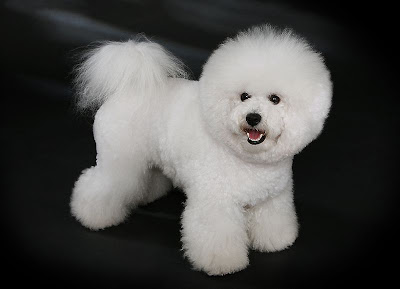When people see my charming little powder-puff of a dog, they invariably ask as to his background. The little Bichon Frise always requires careful explanation because most casual observers think he's a Toy Poodle or Maltese Poodle crossbreed. They are also surprised to learn that instead of being a brand-new breed, the Bichon Frise Dog actually dates back before the 14th century. The Bichon Frise has taken a long time to become known in this country, despite its historic origins. The Bichon Frise Club of American was only founded in the mid 1960's and it was not recognized by the American Kennel Club until seven years later.
Only a few breeders yet specialize on this dog, though doubtlessly the popularity is increasing at a rapid pace, and will continue to do so, especially when the dog's amazing personality becomes more widely known. These little dogs are descended from the Water Spaniel. The term spaniel originated in Spain and was applied to a small shaggy race of dogs in that country. Another name, Barbet, was used in connection with this type of dog, and for a time they also were called Barbichon.
The Bichon Frise was found in the Mediterranean countries in the 1300s. There are four
types:
1. The Bolognese - from the pre-Roman city of Bologna in north central Italy.types:
2. The Maltais - from the island of Malta.
3. The Tenerife - from the largest of the Canary Islands.
4. The Havanese – unknown name origin.
It isn't clear how the Havanese got its name. It could come from Cuba since that country was founded by the Spaniards in 1515 and the port of Havana named. Another possibility is that the name came from Havalange, Belguim, since the people of that country have been interested in the breed for centuries. However, today's origin for our concern is the the Tenerife, since the Bichon as we know it today has descended from this category. It is white with a slight buff or gray color on the ears, sometimes a faint patch of color on the body or all white. The other three types or gray, buff, black, or parti-colored.
For a time the Bichon was called Tenerife, perhaps because of the interest and intrigue it gave this breed when it began appearing in France in the 1500's. Henry III, whose reign lasted from 1574 to 1589, was responsible for the popularity of the little dogs at that time. He carried them about, washed them, exquisitely groomed and perfumed, all in a tray-like basket what was slung from his neck by ribbons. They were equally popular with the ladies of King Henry's court. It is thought by fanciers that the word “Bichonner”, which is a French term of endearment, was used in relation to the Tenerife during Henry III's reign and eventually became “Bichon a Poil Frise”, the last word meaning curly.
For a time the Bichon was called Tenerife, perhaps because of the interest and intrigue it gave this breed when it began appearing in France in the 1500's. Henry III, whose reign lasted from 1574 to 1589, was responsible for the popularity of the little dogs at that time. He carried them about, washed them, exquisitely groomed and perfumed, all in a tray-like basket what was slung from his neck by ribbons. They were equally popular with the ladies of King Henry's court. It is thought by fanciers that the word “Bichonner”, which is a French term of endearment, was used in relation to the Tenerife during Henry III's reign and eventually became “Bichon a Poil Frise”, the last word meaning curly.
Researchers on the Bichon Frise agree that the breed encountered some very unfortunate periods, alternating with times of popularity. One of the bad times was in the early 1900s when the lovely little creatures became an attraction with the organ grinders, a blind man's companion, and was used as a trick and circus dog in Europe. After World War I, breeders in France became interested in the Bichon Frise and again they came into favor. A sound breeding program was begun. On March 5, 1933, the Societe Centrale Canine of France pioneered an official standard, and October 18, 1934, Le Bichon Frise was registered in the book Origines Francais. So the little Spanish dog became French and soon was recognized in Italy and Belgium.
According to the records, the first Bichons, Eddy White de Steren Vor and Etoile de Steren Vor, were brought to the United States in 1956. In 1957 the first litter was born to Etoile. The names Etoile and Eddy appear on many a pedigree of the breed in the United States today. Although the Bichon Frise is often mistaken for his cousins, the Toy Poodle and the Maltese, he is a distinctive breed all his own. He wears a double curly or wavy coat, which usually is soft and dense, somewhat resembling the coat of the Poodle and the softhaired Maltese.
Perhaps these three breeds all were descended from the shaggy spaniels of Spain and through the centuries evolved into the beautiful breeds they are today. Among other breeders, those raising Poodles and Maltese have been attracted to the Bichon Frise, probably because of the similarity and also for the differences. What one finds in the Bichon Frise is a highly intelligent dog with a mild temperament, one that is easily trained in obedience, yet is a doll when it comes to showing. However, he doesn't have the “Yapping” characteristic of the Toy Poodles, and his quiet, good nature endears him to all who know him. The Bichon also adapts incredibly well to apartment life.


















0 comments:
Post a Comment